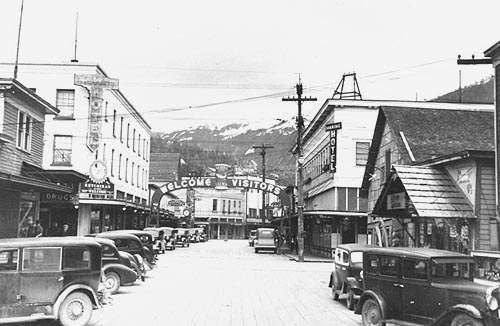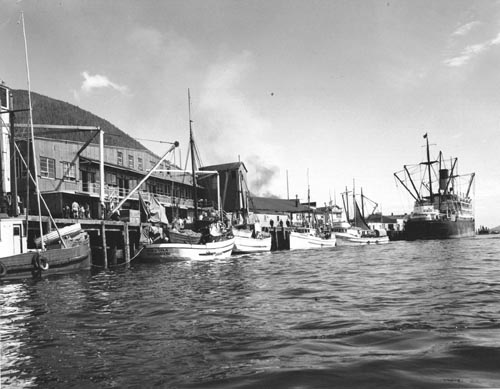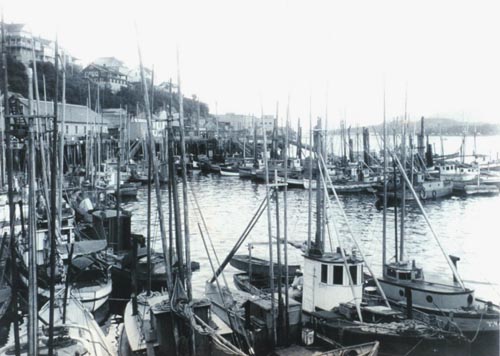 One of a kind By June Allen March 05, 2003
 Photo courtesy National Marine Fisheries Service (NOAA) Ketchikan folk are so accustomed to the welcome arch being there that they probably no longer even notice it. But it was, and is, a very special sign and should be counted as one of Ketchikan's major attractions for two reasons: In all of the United States, it is one of only 40 or so signs still existing in its original "gateway" location, and, it probably is the only one facing not a highway at the city limits but facing a dock! The dock was where visitors arriving in Ketchikan first came ashore - and it still is. It's a perfect location. Beyond the arch stands Deer Mountain in all its glory, backdropped by an Alaska-blue sky - depending on the weather! Anyone doubting the welcome arch's popularity with tourists knows that visiting camera buffs pose the family under the arch as they stand or kneel right in the street to click the perfect shot, slowing traffic and occasioning muted curse words. Resident motorists know to be especially careful at that corner! Why a welcome arch in the first place? Such arches were a national rage in the 1920s, and Ketchikan is and always has been right up-to-date on the latest fads and fashions. And welcome arches were the latest fashion in the Roaring Twenties. After the end of World War I, Henry Ford began to crank out Model Ts from his innovative assembly lines, automobiles that the average worker could afford! The shiny black cars came off the assembly line in the truly "basic" package: the wheels, undercarriage, front seat, body and engine - plus a crank to get it started. Anything else - including headlights, windshield, runningboards - was "extra." Ford himself was frugal and inventive and understood thrift. For instance, he ordered parts from one supplier and demanded that they be shipped in wooden boxes of specific measurements. On arrival, the wooden boxes were broken down and just fit exactly as floorboards in the new cars. And Americans became seriously bitten by the travel bug! In the early '20s the nation's roads left a lot to be desired. Those going any distance took the train. But what freedom a motor car offered! But not only were there too few roads for the new autos, the roads didn't go far enough! The emergence of the motor car as not only a means of travel but as a national pastime put men to work and opened up whole other economic areas. Not only were many men employed building roads, but canny businessmen in towns along the way saw new opportunities in the traveling public as visitors chugged and bounced into new towns with dust-covered suitcases, boxes and canteens lashed to running boards and rear racks of the overheating automobiles.  Creator Haddon, E. P. Photo Courtesy U.S. Fish & Wildlife Service Alaska Historical Image Library - National Image Library Near the city limits overnight accommodations for travelers were built, back then called motor courts or tourist parks. They were almost always separate little cabins or cottages for overnighting, with, at a distance, separate toilet and shower facilities - and often a tap in the yard for getting water for washing up or filling the Model T's radiator. An auto would arrive and the driver might cautiously remove the hot radiator cap, jumping back as a plume of steam hissed up from the radiator. Every driver carried a tin can bent slightly to create a spout and carefully poured cool tap water into the gradually cooling radiator. Innertubes were patched on the spot and hand-pumps filled the repaired tire with air. Then accordian-folded maps were opened and locations studied for the following day's travel. Maps were free at service stations, new businesses that also brought dollars into the economy. It wasn't long before little cafes with EAT signs sprang up near the tourist parks. They were followed by shops offering local curios and collectibles. Then city fathers decided to erect signs at the city limits with the name of the town, followed by other smaller signs that sprouted up, advertising local attractions and bargains. The touring fad grew and grew over the decade. Then someone somewhere decided to build a welcome arch at the city limits, the epitome of hospitality - welcoming tourists and their dollars to their community. That idea too caught on! By the end of the decade there were hundreds and hundreds of welcome arches at the city limits of towns all across America. The welcome arch idea had actually originated with Napoleon Bonaparte long before! The Little General had been impressed with an ancient Roman arch he'd seen in Rome and decided to copy it for his own Arch d' Triomphe in Paris after his triumphant campaign in Egypt. And, celebrating the triumph of tourism in America, America's town and cities continued the welcome arch tradition. Those ubiquitous new welcome arches stood proudly through the Great Depression and the World War II years. At war's end, to accommodate the nation's booming growth rate, new mobility and more modern automobiles and trucks, the nation began to construction of the country's interstate highway system. The surge of widening, realigning, paving and other improvements to the highways meant the end of the arches. The signs were taken down as roads were widened and the city limits expanded to include new neighborhoods, subdivisions, and business developments. Tourism wasn't the primary thrust in this population-transportation highway expansion. In Ketchikan, its welcome arch remained in its traditional "gateway" location on Mission Street, the "entrance" to the city. Wind and weather, however, had damaged earlier welcome signs and they had been replaced with similar signs. Then in 1950 several things made people start to think about the possibility of a modern new welcome arch. The Ketchikan Chamber of Commerce took over the original Ketchikan Salmon Derby from the local Sports and Wildlife Club which had been supported by the Fishing News (now the Ketchikan Daily News). Then came a move to bring the welcome arch message more up to date. The message touting the canned salmon message could be replaced with a more appropriate one about salmon sport fishing and the Derby! The second development was that a neon sign company had moved to Ketchikan, sparking supporters' imaginations.  According to information provided with this photograph, Ketchikan was then the greatest fishing center on the Pacific Coast. Fishing in Alaska then accounted for 80 percent of all employment with most activity limited to the summer months. Photo Courtesy National Marine Fisheries Service Robert "Swede" Zachary and his business partner George Lawrence began the Northern Lights Neon Company with offices on Tongass Avenue near McKay Marine Ways in the late 1940s. They began to interest the community in neon signs, which soon after switched on in business signs across town. Chamber and Rotary members Lawrence Kubley and George Beck and Chamber manager Bill Boardman whipped up the enthusiasm of the town and raised funds for the project. Hometown artist Bill Gabler offered to sketch the new sign's design. The new neon company's Bob Zachary had the skill to do the job. Anyone flying into Seattle may have noticed the neon sign on the Seattle Post-Intelligencer building. It was created by Zachary during in the 1940s. Ketchikan Welding Works founder Don Smothers was recruited to do the new welcome arch's metal work. Eddie Meyers of McGillvray Bros., who also did the Pioneers of Alaska snowshoe emblem and painted a memorable mural for the Masonic Temple, did the background painting of the sign. Then it was time for the glowing new neon sign to be put up. It was erected, according to old newspaper accounts, between Doc Walker's Drug Store (near the old entrance to the now-gone Ingersoll Hotel) and the Marine Hotel (today's Tom Sawyer's). The Marine Hotel was shortly after destroyed in a fire, thought to be an early Firebug arson. The new sign's sturdy standards remained wrapped in canned salmon labels, honoring the town's oldest industry, canneries. The sign's gala dedication was held May 20, 1951. Emery Tobin was master of ceremonies and Mayor Jack Talbot welcomed the crowd. The Kayhi band provided rousing music and the whole ceremony was aired on KTKN radio. Beauty queens were Shirley Liljestrand, Shirley Olin and Carol Shellenbarger. Celeste Gerde took a bow because she was leading in the Salmon Derby that season - but Tony Perkowski would walk off with the Derby's grand prize that year. Sometime, maybe in the late 1960s, the original neon sign gave up the ghost. It was taken down and stored in a city warehouse but no one knows where (or they're not telling.) A wooden totem design welcome arch went up in its place, but in 1994 or maybe 1995, a truck turning the corner wiped out the black and white arch. So in 1995 Historic Ketchikan spearheaded a drive to raise funds to create a new neon welcome arch patterned on the 1951 original neon - a raingear-clad fisherman in a rocking skiff trying to land a fighting king salmon on the other side of the sign. The updated version was designed by Toby Jackson. It was dedicated April 13, 1996. Thank you, Historic Ketchikan. So the next time you drive under or past the welcome arch, consider its history and its message: WELCOME! Welcome, welcome to Ketchikan.
All rights reserved. Not to be reprinted in any form without the written permission of June Allen.
|